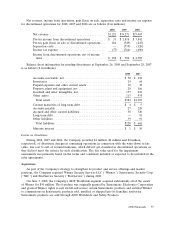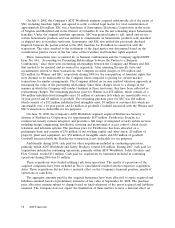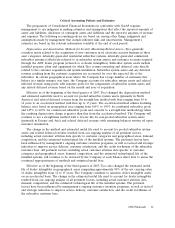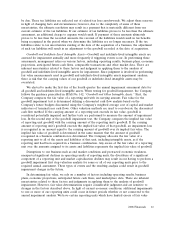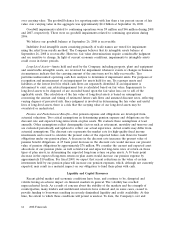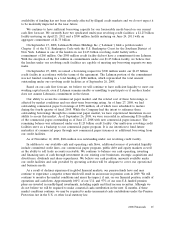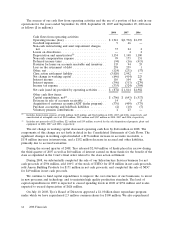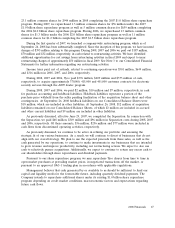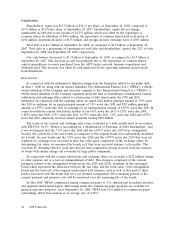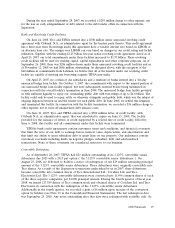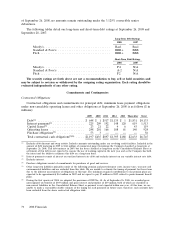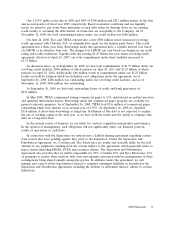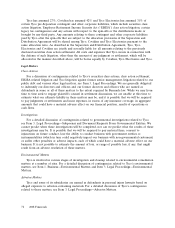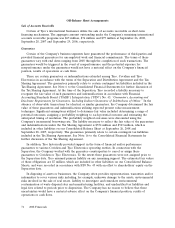ADT 2008 Annual Report Download - page 167
Download and view the complete annual report
Please find page 167 of the 2008 ADT annual report below. You can navigate through the pages in the report by either clicking on the pages listed below, or by using the keyword search tool below to find specific information within the annual report.over carrying value. The goodwill balance for reporting units with less than a ten percent excess of fair
value over carrying value in the aggregate was approximately $2.4 billion at September 26, 2008.
Goodwill impairments related to continuing operations were $9 million and $46 million during 2008
and 2007, respectively. There were no goodwill impairments related to continuing operations during
2006.
We believe our goodwill balance at September 26, 2008 is recoverable.
Indefinite lived intangible assets consisting primarily of trade names are tested for impairment
using the relief from royalty method. The Company believes that its intangible assets balance at
September 26, 2008 is recoverable. However, fair value determinations require considerable judgment
and are sensitive to change. In light of current economic conditions, impairments to intangible assets
could occur in future periods.
Long-Lived Assets—Assets held and used by the Company, including property, plant and equipment
and amortizable intangible assets, are reviewed for impairment whenever events or changes in business
circumstances indicate that the carrying amount of the asset may not be fully recoverable. Tyco
performs undiscounted operating cash flow analyses to determine if impairment exists. For purposes of
recognition and measurement of an impairment for assets held for use, Tyco groups assets and
liabilities at the lowest level for which cash flows are separately identified. If an impairment is
determined to exist, any related impairment loss is calculated based on fair value. Impairments to
long-lived assets to be disposed of are recorded based upon the fair value less cost to sell of the
applicable assets. The calculation of the fair value of long-lived assets is based on assumptions
concerning the amount and timing of estimated future cash flows and assumed discount rates, reflecting
varying degrees of perceived risk. Since judgment is involved in determining the fair value and useful
lives of long-lived assets, there is a risk that the carrying value of our long-lived assets may be
overstated or understated.
Pension and Postretirement Benefits—Our pension expense and obligations are developed from
actuarial valuations. Two critical assumptions in determining pension expense and obligations are the
discount rate and expected long-term return on plan assets. We evaluate these assumptions at least
annually. Other assumptions reflect demographic factors such as retirement, mortality and turnover and
are evaluated periodically and updated to reflect our actual experience. Actual results may differ from
actuarial assumptions. The discount rate represents the market rate for high-quality fixed income
investments and is used to calculate the present value of the expected future cash flows for benefit
obligations under our pension plans. A decrease in the discount rate increases the present value of
pension benefit obligations. A 25 basis point decrease in the discount rate would increase our present
value of pension obligations by approximately $76 million. We consider the current and expected asset
allocations of our pension plans, as well as historical and expected long-term rates of return on those
types of plan assets, in determining the expected long-term return on plan assets. A 50 basis point
decrease in the expected long-term return on plan assets would increase our pension expense by
approximately $10 million. For fiscal 2009, we expect that recent reductions in the value of certain
investments held by our pension plans will increase our pension expenses, which, although not currently
expected, may result in a material impact on our obligation to fund these plans with cash.
Liquidity and Capital Resources
Recent global market and economic conditions have been, and continue to be, disrupted and
volatile having an adverse impact on financial markets in general. The volatility has reached
unprecedented levels. As a result of concern about the stability of the markets and the strength of
counterparties, many lenders and institutional investors have reduced and, in some cases, ceased to
provide funding to borrowers resulting in severely diminished liquidity and credit availability. At this
time, the extent to which these conditions will persist is unclear. To date, the Company’s cost and
64 2008 Financials





